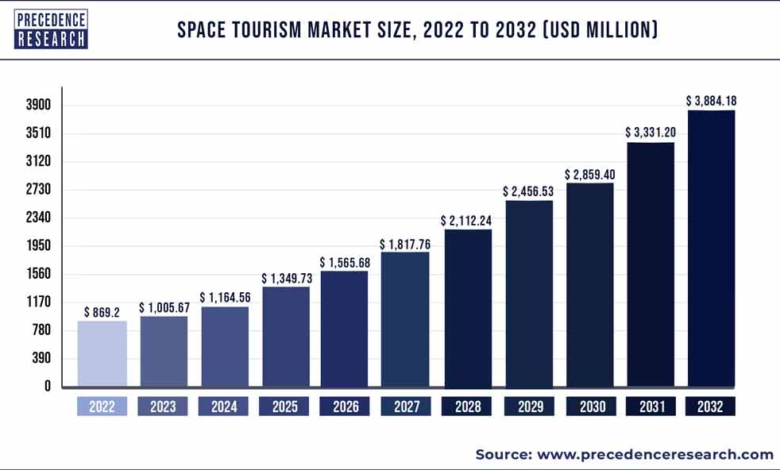Explosive Growth Predicted for Global Space Tourism Market: From $881.56 Million to $35,108.7 Million by 2033

News Mania Desk/Agnibeena Ghosh/28th July 2024
The global space tourism market is on the cusp of a monumental expansion, with its value projected to skyrocket from USD 881.56 million in 2023 to an astounding USD 35,108.7 million by 2033, according to a report by Spherical Insights & Consulting. This represents a remarkable compound annual growth rate (CAGR) of 44.55% over the forecast period.
Space tourism, which encompasses travel to space for leisure, adventure, or pleasure, is no longer the exclusive domain of astronauts and scientists. Companies such as SpaceX, Blue Origin, and Virgin Galactic have pioneered commercial space travel, making it accessible to the general public. The market is divided into suborbital and orbital travel segments, with suborbital flights currently being more affordable and accessible. These flights offer brief periods of weightlessness and a view of Earth from the edge of space, without the need to enter full orbit.
The suborbital segment is expected to dominate the market due to its relative affordability and accessibility. Suborbital flights travel at slower speeds and do not enter orbit, allowing passengers to experience space travel without the extensive preparation required for orbital flights.
Commercial space tourism is poised for rapid growth, driven by technological advancements and increased interest from affluent individuals. The construction of necessary infrastructure, such as spaceships and space terminals, is laying the groundwork for this burgeoning industry. The commercial segment of the market is expected to grow at the fastest CAGR during the forecast period, outpacing the government segment.
North America is projected to hold the largest share of the space tourism market, thanks to its advanced infrastructure and robust research and development base. The region’s ability to rapidly adopt modern technology, coupled with a significant number of small and medium-sized enterprises, is expected to generate the highest revenue for the global market.
While the growth potential is enormous, the space tourism industry also faces challenges, particularly related to space debris. Satellite debris can remain in orbit for years, posing risks to other missions. As the number of satellite launches increases, the amount of debris also grows, potentially causing damage and interference.
Despite these challenges, the space tourism market’s potential to revolutionize travel experiences is immense. The ongoing interest from wealthy individuals and continuous advancements in technology and regulations are expected to make space travel increasingly accessible to the general public. This rapidly expanding industry is set to open up new travel opportunities for both business and leisure.
Key players in the space tourism market include SpaceX, Blue Origin, Orion Span, Boeing, Zero-G, Space Adventure, Zero 2 Infinity, World View, Space Perspective, Nanoracks, and Axiom, among others. These companies are at the forefront of making space travel a reality, driving innovation and growth in the industry.
In conclusion, the global space tourism market is poised for explosive growth over the next decade. With advancements in technology, increasing interest from the public, and substantial investments from leading companies, space tourism is set to transform the travel industry. As the market continues to evolve, it promises to offer unprecedented experiences and opportunities for those looking to venture beyond our planet.






